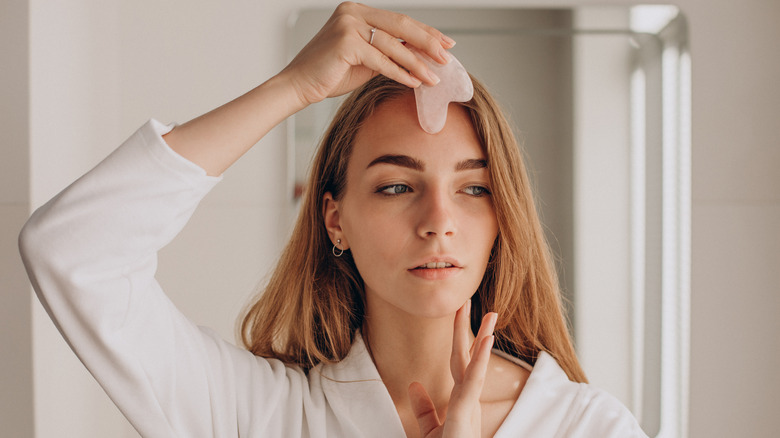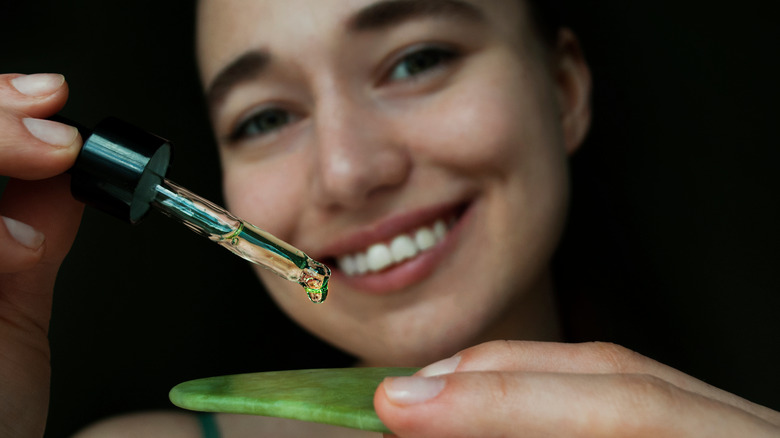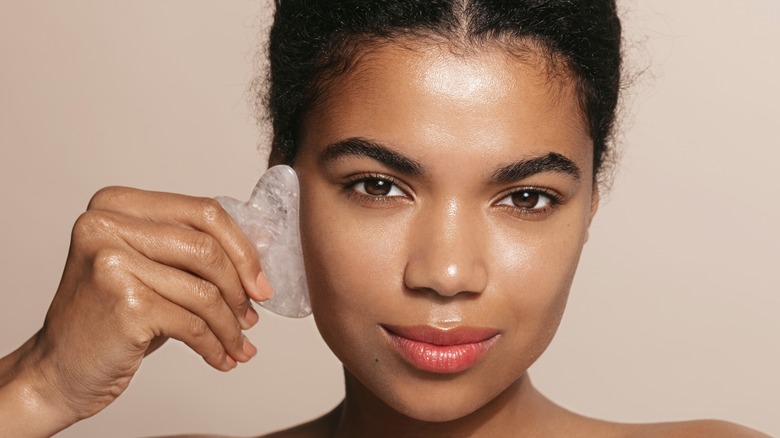Mistakes You Might Be Making When Using A Gua Sha On Your Face
Facial gua sha involves three things: a stone, strategic stroking movements, and your face! The practice first emerged in health and lifestyle communities as a modernized version of a traditional Chinese medicine technique, and quickly became popularized by purported results of anti-aging and stress-reducing properties.
Originally targeting the arms, legs, and back — but now ideally focusing on the face — gua sha uses a smoothed stone to scrape and drain fluid in order to improve circulation and relax muscles. Though the term "scraping" might sound uncomfortable, don't fret! Gua sha movements are calm, and only slight pressure is applied. No literal "scraping" here. In fact, the right stroking movements combined with the smoothness of the stone should be soothing. In addition to reducing stress, gua sha often helps reveal a glowing complexion and cheekbones you didn't know you had.
Thanks to gua sha's growing clout, it was only a matter of time before the practice erupted onto platforms like TikTok and Youtube, giving users a chance to showcase their own gua sha methods and instruction. Yet, because the science behind gua sha is still relatively new — and because it involves stroking sensitive areas rich with lymph, fluid that helps regulate drainage into the bloodstream — some may wonder if there is an innocently incorrect technique when using gua sha. Because of this, it's imperative to be aware of the mistakes you might be making when using a gua sha stone on your face, so you can get results the right way and perfect your practice.
Incorrectly using your gua sha stone
Ready to find those cheekbones in a safe and relaxing way? You may have the urge to start "scraping" immediately after picking up your gua sha tool. Don't! It's important to start your gua sha practice with a clean face, because it allows the skin to be free of penetrating oils and dirt that may get into your skin during your practice. It's also recommended to clean your gua sha tool before use, so no additional germs make contact with your skin.
Another mistake you might be making when using gua sha is moving in too many directions. Experts emphasize stroking in one direction: out towards the edge of your face, so blood flow can concentrate on one specific area. A basic guideline is to start with your forehead, going from your nose to your hairline. Then, move to your cheeks, stroking outwards from the nose to the ear. Finally, use the rounded concave for your chin, scraping along your jawline until you reach your ear.
Your stroking should be precise, verging on slow and steady. This allows the muscles to fully drain and simultaneously relax. Scraping too quickly can cause redness and actually increase swelling in the face, the opposite of what the gua sha is intended to do! Additionally, experts recommend that a full gua sha routine should last anywhere from 10 to 15 minutes.
The benefits of gua sha
Facial gua sha continues to grow within lifestyle and beauty communities as a way to improve circulation, fine lines and wrinkles, jaw and cheekbone definition, posture, and overall skin health. Gua sha is also known to reduce stress and provide a soothing, massage-like experience for anyone practicing.
Understanding common gua sha mistakes like rushing, improperly cleansing, excessively oiling, or moving in the wrong direction can keep prevent feelings of frustration about the process, and instead, inspire the pursuit of a healthier way of living and better skin maintenance. This way, we resist the urge to fall privy to bad habits and instead aim for a more satisfying skincare experience. This will, in turn, hopefully help produce more positive results over time.
Of course, gua sha is still a newly advancing practice, but if we remain consistent and intentional about correctly practicing gua sha, there's a greater likelihood of achieving stronger and healthier results.


